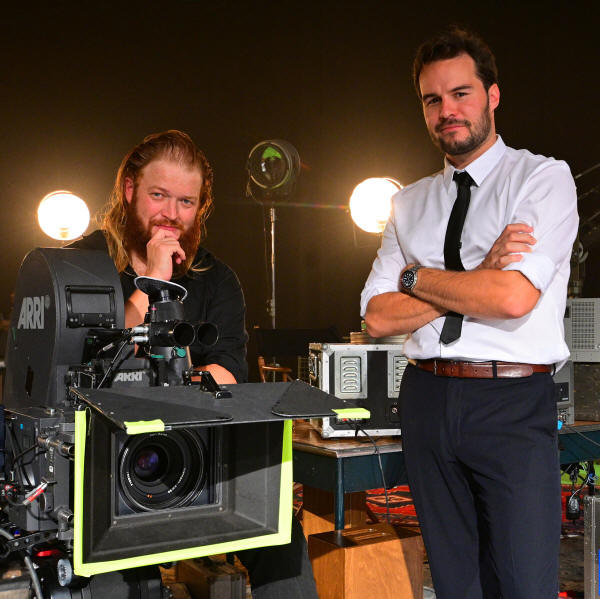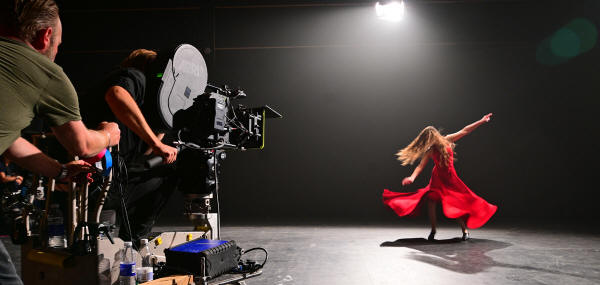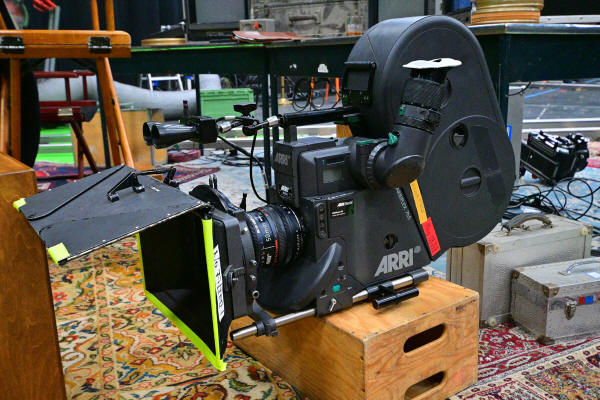A Unique Analogue Workshop Event |
Read more at in70mm.com The 70mm Newsletter |
| Written and photographed by: Thomas Hauerslev | Date: 26.08.2023 |
 Cinematographer
Anders Lindved and Director Jesper Tønnes
with the ARRI 765 65mm camera. Cinematographer
Anders Lindved and Director Jesper Tønnes
with the ARRI 765 65mm camera.On the invitation of Rebel Pictures, in70mm.com and biografmuseet.dk attended a unique analogue workshop event Friday 18. August 2023: a live filming with all four Kodak film formats. It's a prologue to Director Jesper Tønnes' own forthcoming "Nothing Ventured", a short film in four parts photographed in Super 8, Super 16, 4-perf 35mm and the grand 65mm film format! This was the first time a Danish production has been photographed with the German made ARRI 765 camera. Not only that, but the organizers also wanted to share this unique afternoon with everyone who loves film. As digital film making is constantly moving forward, analogue film making is becoming more and more exclusive. Rebel Pictures is still working with film and had arranged a workshop to make a dance short subject film, filmed simultaneously in all four Kodak formats. This was done with the generous support and corporation of FilmGear, Kameraudlejningen, Kodak, Kodak Filmlab, Shutterbug, Arri Rental, Mutascan, FX-TEAM, Social Brew and Chefmania. • Go to Gallery The Making of "CUT" • Go to Help Needed to Finish the Ultimate Analog Short Film This celebration of FILM took place outside Copenhagen at FilmGEAR's studio in the suburb of Herlev. The afternoon was witnessed by film students from Krogerup Højskole, family and friends of the production and a great number of production crew members from the Danish film industry. The audience attending this live filming was also about to play a small part of the film. In the picture! The live filming was produced by Jacob Jayantha and Jesper Tønnes, with director of photography Kristoffer Aabo and direction by Jesper Tønnes ("Nothing Ventured" (partly in 65mm) + "The Last Padawan II") and his crew. The dance film titled “CUT” will be starring Selene Muñoz as the flamenco dancer in a stunning red dress. Behind the cameras were Kristoffer Aabo (Super 8), Anders Lindved (65mm), Camilla Hjelm (Super 16) and Manuel Claro (35mm) and Daniel Parmo on Steadican cameraman with 35mm Arriflex. Cameras and film stock of the day were: Beaulieu Cine 8 (Super 8mm, 200T Vision3), ARRIFLEX 416 S (Super 16mm, 200T Vision3), ARRIFLEX ST (35mm, 200T & Double-X) and ARRIFLEX 765 (65mm, 200T Vision3). |
More in 70mm reading: Help Needed to Finish the Ultimate Analog Short Film Interview With Otto Blaschek - The Making of ARRI 765 Films photographed with the ARRI 765 65mm Film: The Fabric of Magic. Part 1 – The Kodak View Making of BMW 850i A film on historic scaling of Nanga Parbat On Location in Paris with ARRI 765 A Visit to ARRI in München, Germany In the Movies with Gerhard Fromm Logmar Camera Solutions premieres a new hand-held 65mm Camera The Invisible Magic Power of 70mm in70mm.com's Library Presented on the big screen in 7OMM Peripheral Vision, Scopes, Dimensions and Panoramas |
 Dancer
Selene Muñoz on front of the ARRI 765 65mm camera, with Anders Lindved as
Director of Photography, and dolly grip Bowie Bak Craner. Dancer
Selene Muñoz on front of the ARRI 765 65mm camera, with Anders Lindved as
Director of Photography, and dolly grip Bowie Bak Craner.My wife and I arrived just before 15:00 in the afternoon. Film Students from Krogerup Højskole were being briefed about the events by one of the production assistants outside FilmGEAR's studio building. We went inside the smoke filled studio and met Director Jesper Tønnes who welcomed us to this public demonstration. The cameras were all lined up on dolly tracks, and camera set-ups and movements had been rehearsed for several days. Plenty of tape marks on the floor. A huge 20 meter wide and curved LED screen served as background for the filming. Opposite in the studio were half a dozen vintage studio lights set up purely as decoration we were told. The cameras and their crews attracted a lot of attention, especially the ARRI 765. Three people are required for every camera. One focus puller, one dolly grip and of course the cinematographer him- or herself. For me it was fun to see the ARRI 765 again. I saw it when it was brand new, during a presentation at Photokina in Köln in 1990, once again in 2007 and 2009, and now right here, 10 minutes from my own home! This afternoon it was equipped with a 50mm Carl Zeiss Distagon lens, re-housed for use on the ARRI 765. I had a chat with cinematographer Anders Lindved about the camera and also Sascha Mieke, the German technician from ARRI Rental. It turned out Sascha and I have a mutual friend in München - Cameraman Gerhard Fromm who arranged a visit to ARRI for us in 2009. Sascha explained that out of the ten 765 cameras originally made in 1989, only six cameras are operational today. Nicknamed "The Old Ladies", all 65mm cameras are based with ARRI Rental in München (Germany) and only rarely used these days. Spare parts are becoming more and more rare, and the electrical boards in the nearly 35 year old cameras are very hard to maintain. |
|
 ARRI
765 65mm cameras - nicknamed "The Old Ladies" - are based in München
(Germany) with ARRI Rental and only rarely used these days. ARRI
765 65mm cameras - nicknamed "The Old Ladies" - are based in München
(Germany) with ARRI Rental and only rarely used these days.Refreshments were served in the studio. To the side was a big table with TV monitors linked up to the cameras where Jesper could follow the production once the cameras were rolling. People were walking around, taking pictures and talking to the camera folks and film crew alike. As the clock approached 16:00 all guests, friends of film, families, the production team, students and our selves lined up behind the cameras. We were paying attention to what was going on to prepare the filming of this short subject this afternoon. Probably the first time in recent years an event like this has taken place with all four formats simultaneously. ("The Fabelmans" were only filmed in 8mm, 16mm and 35mm) The crew was buzzing around, and finally Director Jesper Tønnes took the microphone and welcomed everyone. Jesper - dressed in a white shirt and tie - explained in a very calm voice how hard they had prepared this, and how the next hour or so was planned. He also expressed his enthusiasm for Kodak film, and how exciting it was going to be to shoot this film on FILM in four formats, and not least to see what that meant for the story. He thanked his crew, partners and everyone involved. The actual shooting was planned to take 90 minutes with a break in the middle to change camera position, including putting the ARRI 765 on a crane. Before the actual shooting began, we were all directed to stand casually behind the four cameras. As part of the story, we (the guests) were all going to be in the movie. Selene Muñoz as the dancer would enter the set through a huge studio door. She would walk past us, and into the middle of the studio to the tape mark on the floor, and then clap her hands to complete the take. She was followed by a fifth camera man with an ARRI camera loaded with 35mm black and white film on a Steadicam rig. "Don't look into the camera, but look at the dancer, and hide you mobile phone, please", and then "Roll camera, music, slate, and action!". This was rehearsed two or three times, until the director was satisfied. Once again, only this time with the camera rolling, and everyone concentrating, until the director and first assistant yelled "Cut!". |
|
 Cinematographer
Anders Lindved with Camera technician Sascha Mieke, from ARRI Rental. Cinematographer
Anders Lindved with Camera technician Sascha Mieke, from ARRI Rental.An odour of burned electrical boards near the 65mm camera suddenly appeared. Sascha disassembled the 65mm magazine and took things apart to see what went wrong. I think he concluded it was the video assist part that did not work any longer. He changed a fuse in the camera and it came back to life and filming could continue with new set-ups. Two or three takes with Selene Muñoz dancing. Between takes her hair dresser adjusted the make up and hair. Cameras were rolling so quietly it basically was completely silent. Very impressive. The ARRI 765 included. It is built like a tank, and is in fact a soundproof camera, but also very heavy. almost 30 kilos. Not suited for hand held work at all. I assumed the IMAX 65mm cameras were even heavier - being almost the same size as a small refrigerator. To which Sascha replied, "No, they are in fact much lighter, as they are largely built of aluminium, and not as a sound camera". That explains why a cinematographer like Hoyte van Hoytema can carry it on his shoulder (almost) with ease. Jesper said "Cut!" or "Thank you", and then it was time to re-arrange all camera set-ups. The studio was getting warmer and warmer as the afternoon went on, and it is evident that working on a film production requires patience. It's hard work and everything is choreographed like a ballet. Everyone knows where to be at the right time - at least for me it seemed to be like that. The event was scheduled to end around 19:00, but with some delays, technical challenges etc., it was close to eight in the evening before Jesper thanked everyone on set, and the event had come to an end. It was a very interesting experience to be part of this event, and to watch the filming and see the professionals work. I look forward to see the footage which Jesper promised he would make available to the audience once it was developed. • Go to Logmar Camera Solutions premieres a new hand-held 65mm Camera • Go to The Invisible Magic Power of 70mm Not including 65mm test footage made with Logmar's Magellan 65mm camera in 2018 and some 65mm tests in Tisvildeleje during winter 2020 several major 65mm productions have been made in Denmark before: Parts of "Song of Norway", "Samsara" and "TENET", were photographed here, but "CUT" - a dance short film - is the first real film being produced in 65mm in Denmark. Let's see it IN 7OMM! |
|
 • Go to A Unique Analogue Workshop Event • Go to Gallery The Making of "CUT" |
|
| Go: back - top - back issues - news index Updated 28-07-24 |
